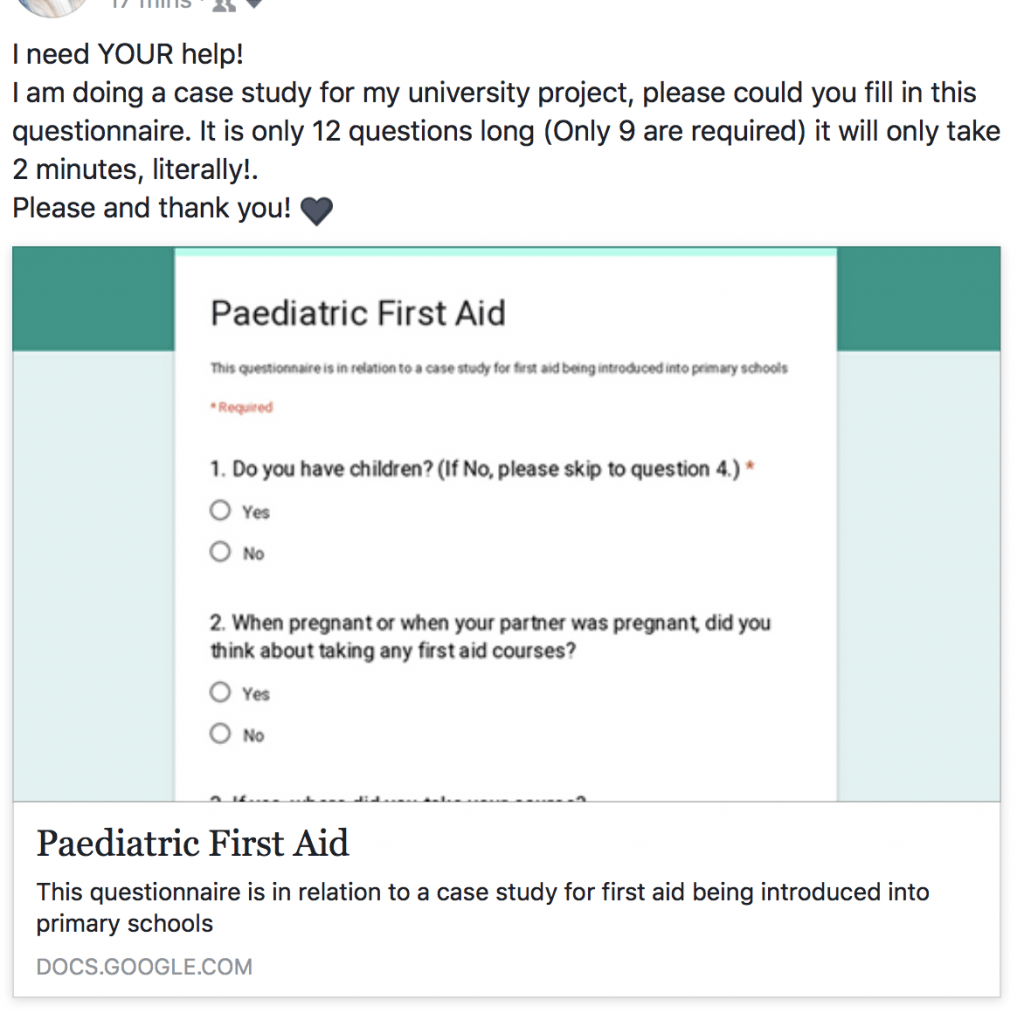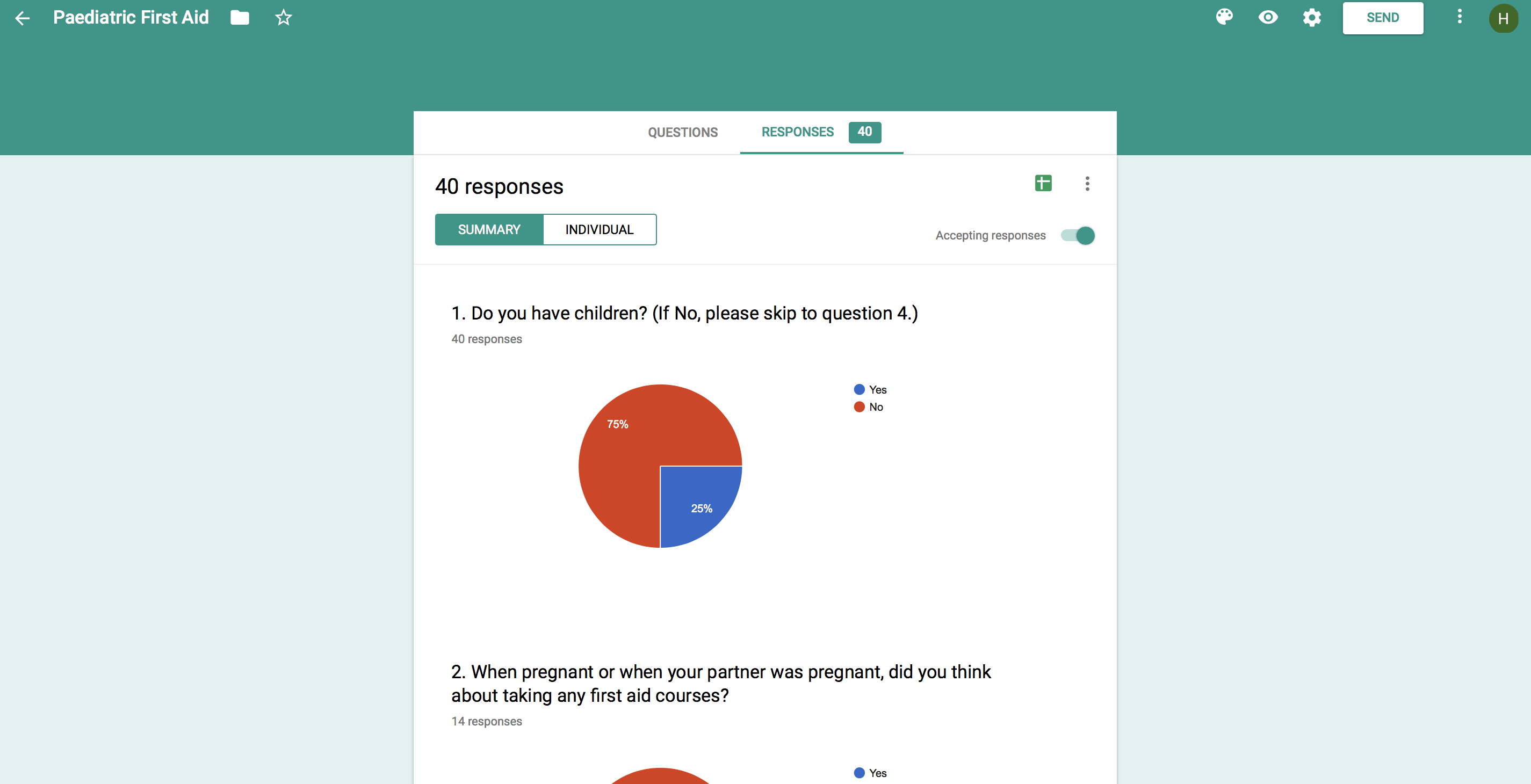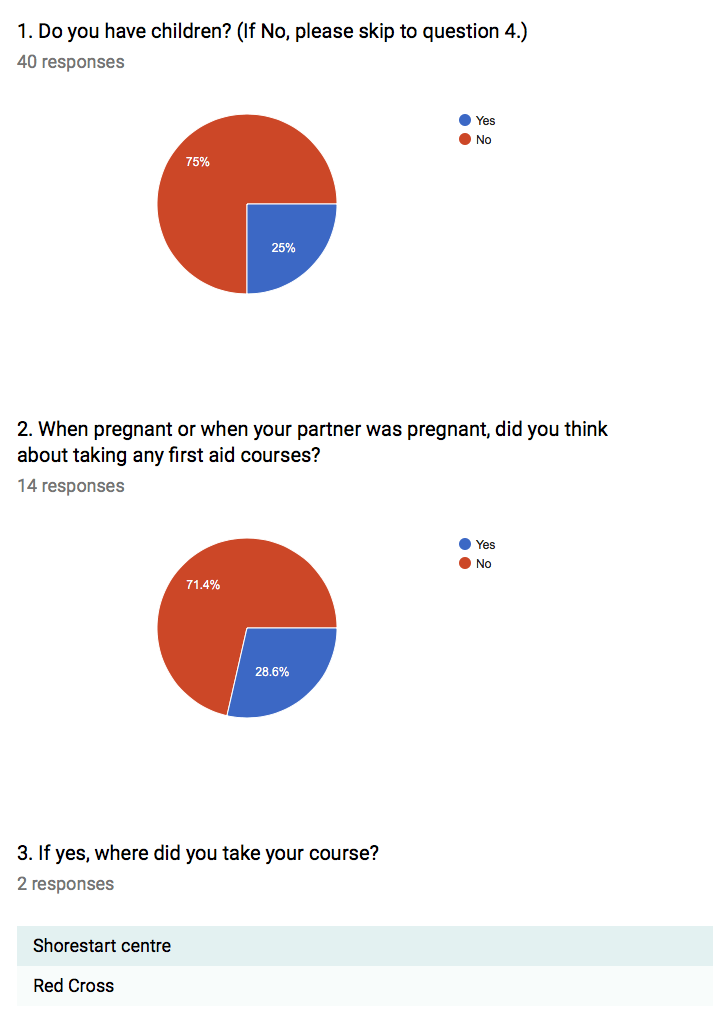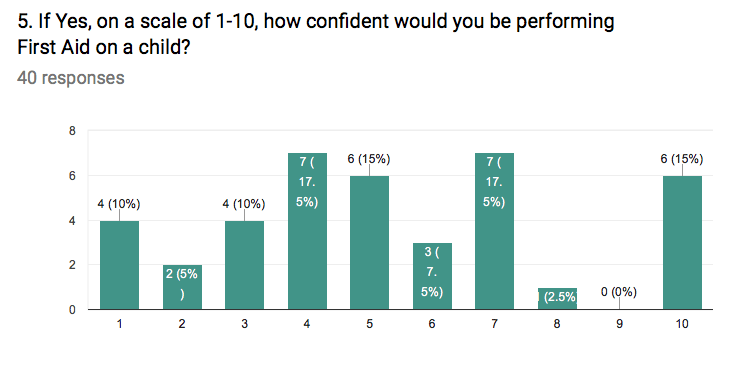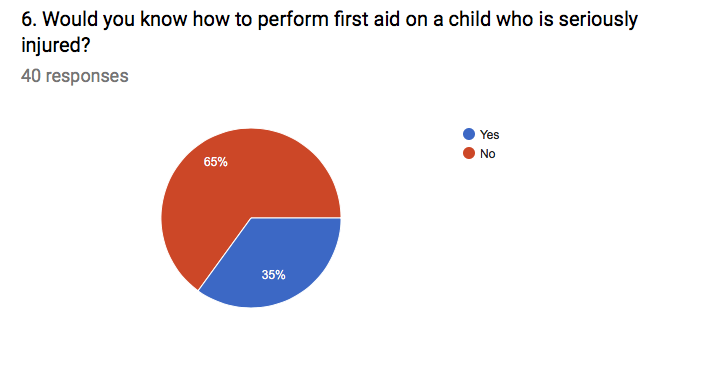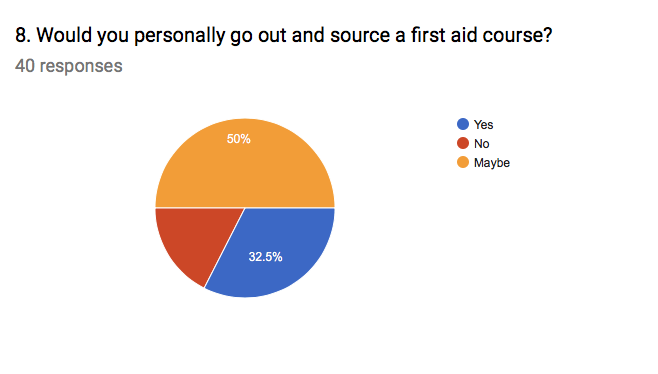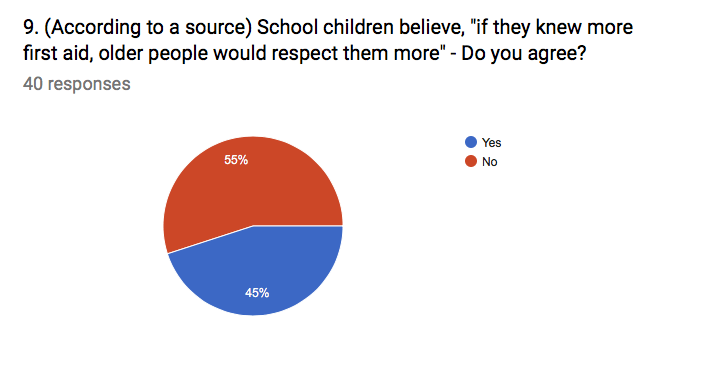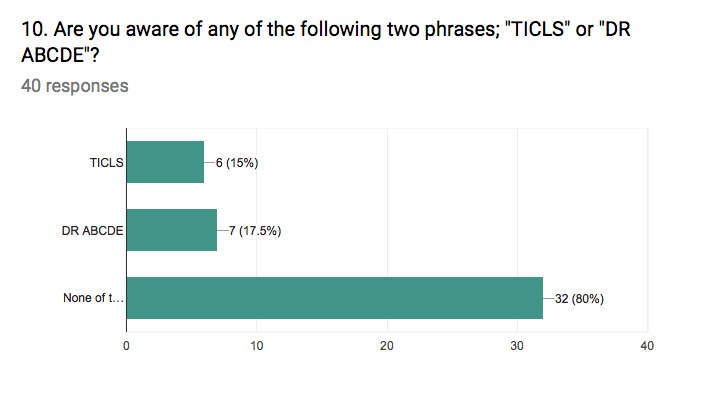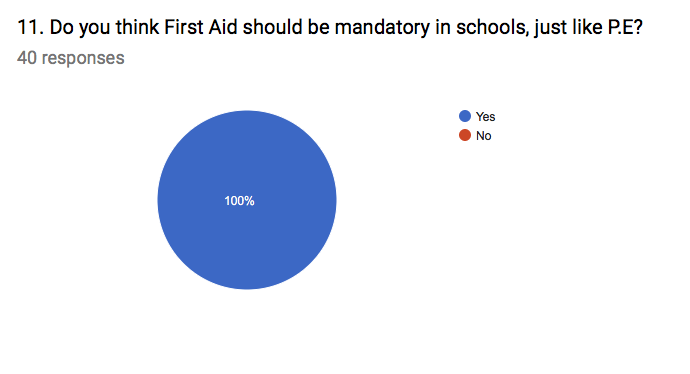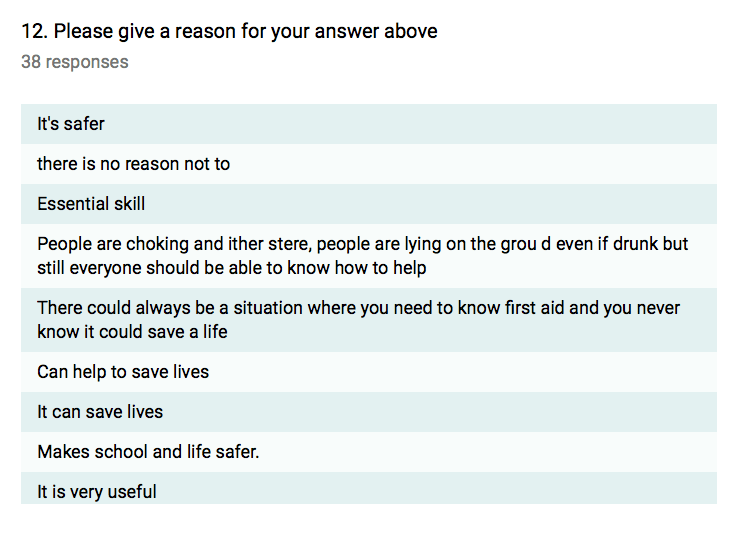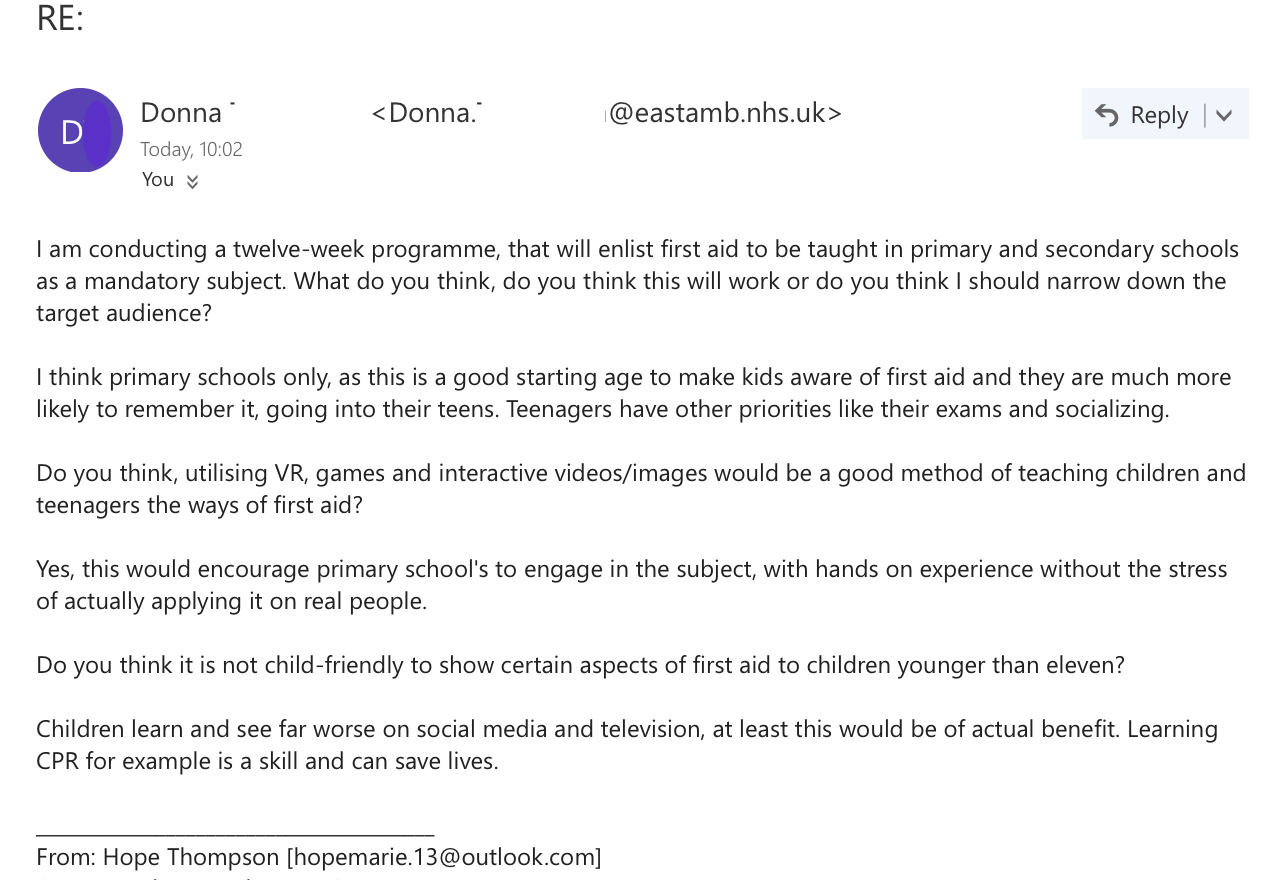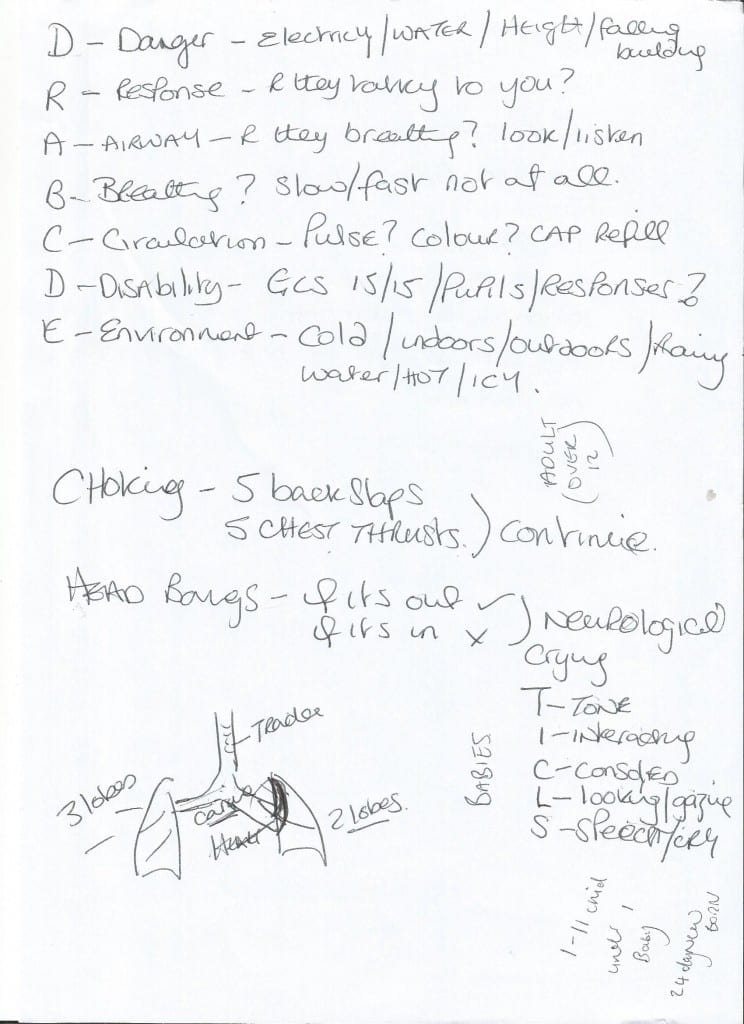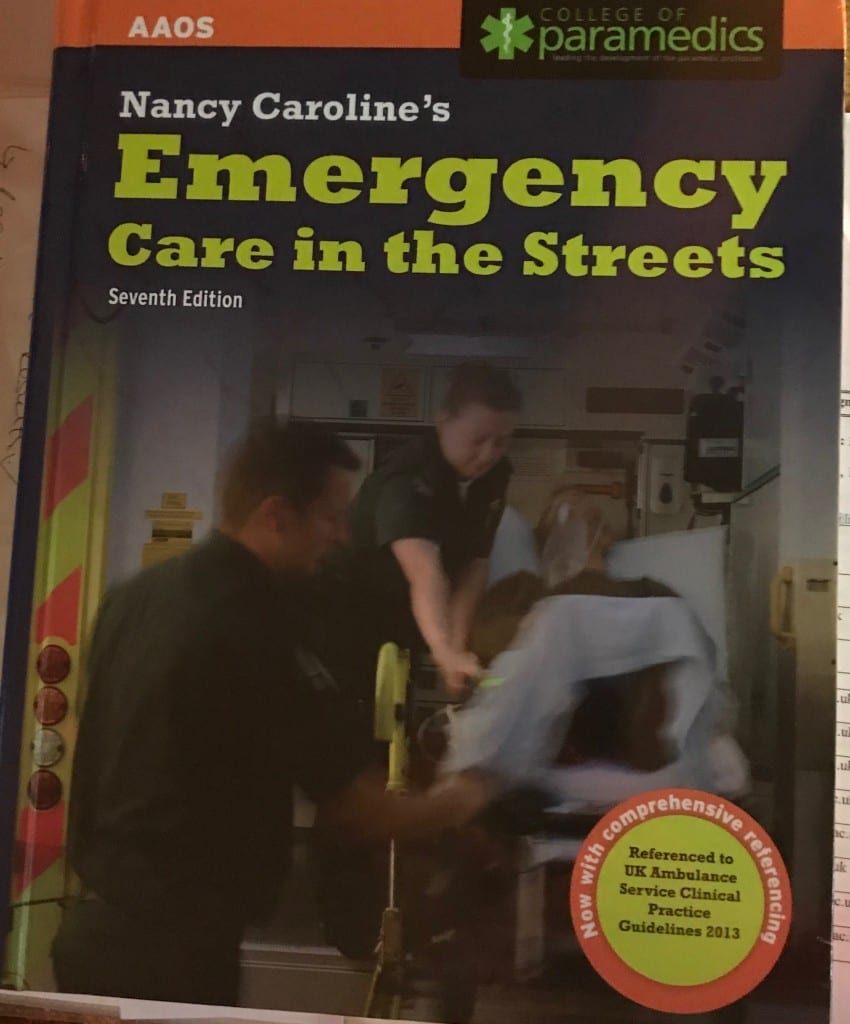Questionnaires
Independent – Week 3
~~~
I created a questionnaire on Google Forms, I then shared this questionnaire on my social media pages (Facebook, Instagram, Snapchat etc.). Alongside this, I sent it to group chats I have with several classes from around the university. I also sent it to all my contacts on my phone. This way I could get a very varied response, and it would help me examine this project widely and fairly.
Here is the link to the Google Form questionnaire; – https://goo.gl/forms/KtvIuwTopauRACNg1
Here is the PDF that the questions are situated on; – Questions PDF
Below is one example of where I put this link.
The reason this questionnaire is aimed at everyone except children, is because they are not really able to respond the way an adult can. It is easier to target an older audience, because they will be able to speak from experience and from envy. For example, I wish I could have had the opportunity to learn first aid. I have always been aware of Health and Safety, and the fact I did a combined course in Health and Safety and this has helped with my knowledge of a lot of things, but I wish there was a first aid element. “The data collection will be in a quantitative manner. The focus group will be in a qualitative manner. For the questionnaires, I will analyse the data by using the structured questionnaires to gather the statistical data and compare with each other and this will allow me to find a final course of action.”
I am really surprised and thrilled with the results I got from this questionnaire, I left the questionnaire up for just over twelve hours and I received forty (40) responses. Within the first thirty minutes, I got fourteen (14) responses, this just goes to show that social media has it benefits in terms of conducting primary research, and other important public generated queries. In the beginning plan, I mentioned I only needed to get twenty responses. I have got double this amount, which has really exceeded my expectations and is going to help me get a better reading for my results.
Firstly, question One, Two, Three.
These three questions are all interlinked into one. Question one had 75% of people responded saying they do NOT have children and 25% of people saying they do have children. I was a bit disappointed, that not many people with children took part, I was hoping for a fifty-fifty response that way it could be an even statistical result. However, the further results made me realise they are just as important because they are just as influential and are just as relevant in terms of the education side. It has made me realise that people without children are just as accessible. I was not surprised that 71.4% of the responders (with children) said they would not go out and find a first aid course, this makes me think further into things being accessible in the early stages of life, and the benefits it could have. I only got two responses to the name of courses. ‘Shorestart centre’ and ‘Red Cross’, I have never heard of the Shorestart centre. I would have to research into this further. (Below the results). I gathered that the question got skipped due to the fact it was not required* and it was the first question where you had to write something in, instead of tick a box.
Question Four;
I was very surprised to see a similarity in percentage between ‘Yes’ and ‘A little’, I believe it depends who I asked and what sort of profession they are in. I was very surprised with the low percentage of people saying ‘No’. As I said, I believe it depends what type of profession they are in. In most retail roles, they require certain people to have basic knowledge of first aid, most places pay for you to go on a course. Below is a chart that explains the theory of people being first aid trained in work.
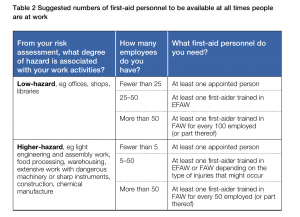 Courtesy of HSE GOV, they have developed a table that refers to FAW and EFAW guidelines. This table shows how many people should be appointed in relation to the number of employees there are, in a low hazard environment there must be ‘at least one first aider trained for every one hundred employed’ (HSE Gov, 2014, 7). (http://www.hse.gov.uk/pubns/indg214.pdf)
Courtesy of HSE GOV, they have developed a table that refers to FAW and EFAW guidelines. This table shows how many people should be appointed in relation to the number of employees there are, in a low hazard environment there must be ‘at least one first aider trained for every one hundred employed’ (HSE Gov, 2014, 7). (http://www.hse.gov.uk/pubns/indg214.pdf)
Although 50% said yes, I still believe it is a good idea to enlist first aid into schools because one or two days of teaching and learning is not enough for someone to fully understand what to do. In most circumstances, people lose all thought process and cannot remember what to do. You might get taught vital skills in a class for a day, but then you may not ever use it again or you may only use it once every two, three months. After this time, how can you remember everything from roughly four/six hours.
Question Five;
This response is so varied, its hard to comprehend. I was very surprised to see six people said they were the most confident in treating a child. These people must have a medical background, for example; Nurses, doctors, paramedics etc. They could either have full appropriate training in first aid.
Question Six;
I worded this question in a way that did not include first aid for adults, typically, someone would only get training on adult first aid and not paediatric first aid. Therefore, I worded this question so that they would not think about adults. I was in the room when someone was filling it out and I heard them say “well I could on an adult… I get it, this is exactly what is wrong”, so it was good to know that 65% of people would not know how to perform first aid on a child who is seriously injured, if I compare this to the (previous question), 42.5% of people who said they ‘feel confident’ performing first aid, it made me wonder if they would really know what to do. Especially when only 35% said they would know what to do in case of something serious.
Question Seven;
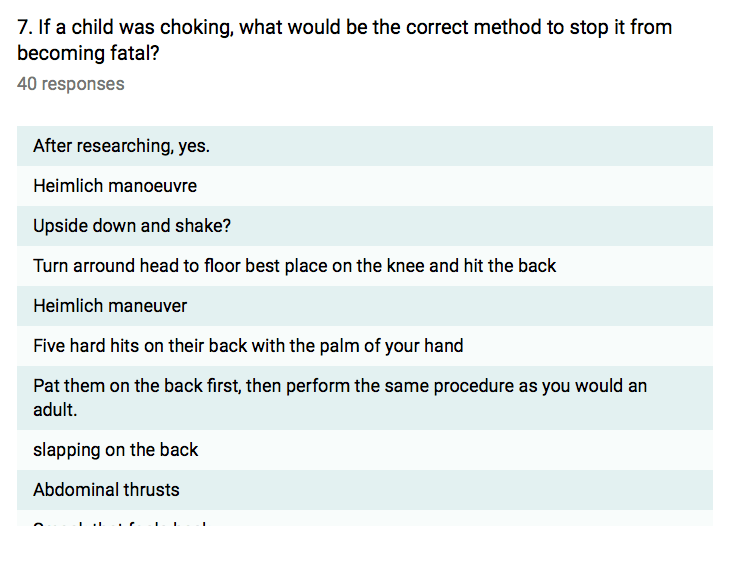 These results to this written question made me laugh, cringe and feel enthused.
These results to this written question made me laugh, cringe and feel enthused.
⊗ After researching, yes. *
⊗ Heimlich Manoeuvre *
⊗ Upside down and shake? *
⊗ Turn around head to floor best place on the knew and hit the back
⊗ Heimlich Manoeuvre *
⊗ Five hard hits on their back with play of your hand
⊗ Pat them on the back first, then perform the same procedure as you would an adult *
⊗ Slapping on the back
⊗ Abdominal Thrusts
⊗ Smack that fools back *
⊗ Slap the child on the back to try and dislodge the object
⊗ Swinging upside down followed by backslaps
⊗ Coughing, patting, abdominal thrusts
⊗ Unblocking airways by slapping on back, turn child over onto front and pat on back between shoulder blades
⊗ Clear the airway
⊗ Encourage to cough. Back slaps. Abdominal Thrusts
⊗ Gently but firmly pat them on the back and/or get them to a hospital asap *
⊗ Back blows/abdominal thrusts
⊗ Whacking their back
⊗ Slap it on the chest a bit *
⊗ Not sure *
⊗ Look for obstruction hook out if possible light backslaps
⊗ Heimlich Manoeuvre *
⊗ Heavy patting of the back
⊗ Pat them on the back
⊗ Firm hit on the back, I think. *
⊗ Back slaps
⊗ Arms around waist quick jerk from behind hoping it would dislodge the obstruction. Hard slap on back all I could do *
⊗ Smack it’s back over your knee
⊗ Not sure – Prevent anyone from crowding over them of course, and call an ambulance *
⊗ If it was really serious try and make the child gag to try and clear the throat, ring 999 *
⊗ 1- if you see the object ty to remove however you need to be careful that you don’t force it down there mouth future than it is as it can cause obstruction to the airway. You may begin to hear your child’s cough our allow them to do this and bring them object up themselves whatever you do don’t leave them alone. 3- back blows. Chest thrust or abdominal thrust depending on the age of the child to which procedure. 5-999
⊗ n/a *
⊗ Hypo something *
⊗ Back slaps, chest thrusts, CPR
⊗ Back slaps and j abdominal thrusts
⊗ Upside down, 5 back thrusts
⊗ Pat on back or hang upside down
⊗ Lean child forward and pat their backs/ 5 back thrusts
⊗ Heimlich *
Overall, some of these answers were pretty good. They were a little uneducated and some were almost correct, however, the others… Some were surprising. I will go through the ones that are highlighted red and marked with a star. Firstly, the first one said ‘after researching yes’, just because they have researched does this mean they are qualified or able to do the practical duties? I believe not, but it depends how well and through they have done their research. I received five Heimlich Manoeuvre response, which is correct in some cases. However, as the question states ‘If a CHILD was chocking, what would be the correct method to stop it becoming fatal?’ these responses are for an adult, typically you would not give a child/baby the Heimlich because it could cause further injuries. The upside down and shake one frightened me a little bit, this could cause major injuries. However, I think I understand what they were trying to say. ‘…then perform the same procedure as you would an adult’, this is utterly incorrect and dangerous. ‘Smack that fools back’, clearly someone thought they were being funny when they filled this out. Gently but firmly pat them on the back and/or get them to a hospital asap, this is correct but I highlighted it because I was pleased they did not say, call an ambulance, this would take up further time and they might not get one straight away. I got five unsure answers, this is fine, not everyone would know what to do, and it proves people need more training. One call an ambulance answer, which is good and it is what people are told/taught to do but it does not always work, there is not enough to go around.
Question Eight;
It is interesting to see that 50% would think about going out to source a first aid course. But in reality, it is more about how expensive they are, or it depends on the location in which it is held. I was surprised that people as little as 17.5% said no, I thought this number would be much higher. However, this could sway in my favour, because the 82.5% would be open to attending a first aid course, which could coincide with my project.
Question Nine;
This answer was nearly a fifty fifty. With only 10% shy, my conclusion or assumption of this is it could be a matter of age demographic. Older people may disagree and young people may agree, either way, it might not be a matter of respect. As a result in my focus group, some said it is not a matter of respect, it is a matter of old vs. young. With everyones life experiences, they will be completely different. This young generation lives completely different to how our parents / grandparents lived, things are more expensive and our attention spans are less, it is a matter of principle that will never be solved.
Question Ten;
It did not surprise me that 80% of people said they did not know the two terms, (TICLS – DR ABCDE). These two phrases stem from child first aid, they are part of a curial diagnosis system that determines what type of treatment you need to give the child.
Question Eleven;
I was thrilled that everyone singles person said YES, this just goes to show that the government should do something about it. More people would be acceptable and aware of First Aid, just as they are for PE. First aid classes, could divide a more fun and practical way into learning.
Question Twelve;
Question twelve was a follow on from question eleven (Do you think First Aid should be mandatory in schools, just like P.E?), this generated a really positive response. Below I will put all the ‘relative’ replies.
⊕ It’s safer
⊕ There is no reason not to
⊕ Essential skills
⊕ People are choking and dying, people are lying on the ground even if drunk but still everyone should be able to know how to help
⊕ There could always be a situation where you need to know first aid and you never know it could save a life
⊕ Can help to save lives
⊕ It can save lives
⊕ Makes school and life safer.
⊕ It is very useful
⊕ Saves lives, people would be able to help save the lives of old and young people if needed
⊕ It would educate them and hopefully stop people walking by in the street if anyone is in need of first aid until paramedics turn up
⊕ Everyone will know a degree of first aid instead of a minority who do a course off their own back. I think it would seem less intimidating if it was just another part of schooling.
⊕ It could save a life down the line
⊕ To prevent serious injuries and to help save people’s lives.
⊕ Performing First Aid, especially on young children, or at least having the knowledge to do so seems to be more of a practical skill than one which can be learned in P.E. which is already a mandatory course subject until a certain age.
⊕ Give children confidence. Children are such sponges.. they would naturally educate family members who knew little. Simple first aid knowledge saves lives
⊕ Everyone should be able to perform basic first aid in case of an emergency
⊕ If everyone knew basic first aid it could save lives and paramedics time.
⊕ Because it could be a necessity in a vital situation and is more relevant than some of the subjects on the curriculum⊕
⊕ It can be used in everyday life when least expected
⊕ It is likely with today’s society that at some point in your life you will be required to do so sort of first aid. Teach whilst young and then it may be a protection that they will become interested in. Ie Ambulance. Doctor nurse.
⊕ I think everyone should have a basic knowledge of what to do in an emergency situation.
⊕ Accidents can occur anywhere.
⊕ Everyone should have a basic knowledge especially how to deal with issues such as diabetes hypos and hypers, epilepsy and so on
⊕ Would have been great to learn something useful at school.
⊕ Basic first aid would help children in time where they’re unable to get help immediately
⊕ It would be. Very helpful when kids are playing alone and the child can try to help
⊕ Possibly stop fatalities
⊕ at the end of the day, it’s a matter of life and death. And some lives may need to be saved before an ambulance turns up to prevent the incident from becoming fatal. The more people who have an understanding means more lives will be saved.
⊕ In turn helps children look after themselves better, may save someone’s life one day and may inspire more to go into medicine and the medical field
⊕ I agree first aid should be mandatory as everyone who knows it can help in a way even if it’s simple. It would take the strain of 111 or A&E/ wall in services. The feeling of helping from saving their lives to being able to support. First aid is a big subject to learn and will take time. From cuts to CPR. I believe it depends on which age group kids will take it seriously? Also on the kid as some people can’t stand blood where others like blood and gore.
⊕ In my opinion introducing First Aid to school pupils from as early as Year 6 or 7 would make them aware of what do when it comes to serious situations. For example, if one of their friends collapse.
⊕ Everyone should know basic CPR and first aid. Everyone should be able to start compressions the quicker on someone’s chest the better the outcome
⊕ Everyone should be able to help other people
⊕ Like pe they would learn essential skills
⊕ Because it could be life-saving
⊕ It will save more lives
⊕ Vital skills
____________________________
What is shorestart centre? – I actually looked into this and nothing came up, except an advisory in spelling. Therefore, in further digging, i found out that whoever filled in this form meant ‘Sure Start’. This place is a children’s centre (daycare centre) that provides help and support to new/old mothers. There is one based in Boston, Skegness, Lincoln and many, many more all over the country. (Here is the link to some examples; – https://www.lincolnshire.gov.uk/parents/childrens-centres/skegness/
https://www.gov.uk/find-sure-start-childrens-centre
___________________________
Here is the link to the results page for my questionnaire (Google Forms).
https://docs.google.com/forms/d/1ilCA2b0NfzVFc9mBz-Dqz0wrJS23wqNQNneZPyo-RLQ/edit#responses
Expert Responses
Donna is a paramedic at the East Anglia ambulance station, (courtesy of prospects), this is what her job entails of;
‘As a paramedic, you’ll provide immediate response to emergency medical 999 and 111 calls. You’ll usually be the first senior healthcare professional on the scene and the level of care you provide can range from dealing with life-threatening conditions to minor illnesses and injuries.
You will need to assess a patient’s condition and provide essential treatment which could include:
- resuscitating and stabilising patients;
- using high-tech equipment e.g. defibrillator;
- applying spinal and traction splints;
- administering intravenous drips, drugs and oxygen.
Emergencies can cover injuries, sudden illness, and casualties arising from road and rail accidents, criminal violence, fires and other incidents.
You’ll typically work in a two-person ambulance crew alongside an ambulance technician or emergency care assistant. It’s also possible to work alone, using an emergency response car, motorbike or bicycle to get to a patient.’ Click here to view the full website
I asked this medical professional three questions
- I am conducting a twelve-week programme, that will enlist first aid to be taught in primary and secondary schools as a mandatory subject. What do you think, do you think this will work or do you think I should narrow down the target audience?
- Do you think, utilising VR, games and interactive videos/images would be a good method of teaching children and teenagers the ways of first aid?
- Do you think it is not child-friendly to show certain aspects of first aid to children younger than eleven
This is her emailed response.
In the questionnaire, I spoke about DR ABCDE and TICLS. Below is a diagram of things i researched in order to find out what they both mean.
I got these examples from a book called, Emergency care in the streets, written by Nancy Caroline.
